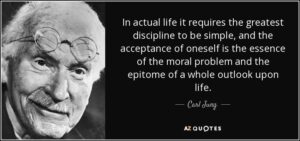Vera von der Heydt began to read Carl Jung’s work, beginning with ‘Modern Man in Search of a Soul’ which she thought the most important book that had ever come her way. Although meeting Jung at a conference, and sitting next to him at dinner one night, she felt unable to ask him any questions as she felt his ideas were beyond her comprehension. Analysis was too expensive and also, she knew no one who might see her. When the Second World War began Von der Heydt was interviewed by the police about why she was in the UK, but could only answer on the strength of her parent’s connections and relations of her mother. This she felt left her feeling invalidated, and the choice of the country also felt of less value, and at this point of feeling she was unacceptable she sought therapy. After two analysis and time spent in Zurich, more meetings with Jung where she did feel able to speak and could describe her work in a clinic, Von der Heydt became a member of the Society of Analytical Psychology. Jung’s psychology gave her a sense of self-acceptance:
‘It was Jung’s approach to the individual which meant so much to me. He did not think in terms of how somebody should be, but who the person was. He attempted to understand the individual by studying the ways in which the person had expressed their fears and longings in the past. … Jung symbolically accepted … dark, hidden spirituality … it was this attitude that gave me a sense of validity and of wholeness’.
So, what is self-acceptance? Von der Heydt sees it as a universal issue. We all have difficulties from the past with our parents; we all have difficulties in relationships and with partners; we are all afraid and lonely; we’re all afraid of being angry, and, we are all looking for meaning in our lives, hoping to relate to something which is more than ourselves. Above all we all want to be loved and accepted and forgiven, and to be helped to acknowledge and confess our weakness and shame. We are individual and have to solve our problems in individual ways, but our bodies and our psyches are so alike. Relating to each other sometimes in harmony, sometimes following in rhythm with another and sometimes being followed, our inner work is to bring into consciousness these dynamics and so understand ourself and the other person.
Through Jung and his ideas Von der Heydt writes that: ‘I learnt to look at myself without comparing what I was with something or someone else, without condemning myself, but as far as possible taking responsibility for my flaws.’ She describes how people often questioned how she could be a Jungian analyst and a member of the Roman Catholic church. Whilst from the purely intellectual point of view there can be no answer to that question, she says the answer is simple – as not a thinking type, she apprehends and comprehends ‘from a centre other than mind’.
‘I would say that Jung’s approach and attitude … has enriched my faith and kept any doubts I may have healthily in consciousness. Conversely my faith has illuminated many of Jung’s ideas and helped me to understand what he was trying to do and what he hoped to achieve on his way to experience and greater awareness.’
